Appendix A & B
Appendix A & B - PISA 2018 Recruitment & FT Communication Materials.docx
Program for International Student Assessment (PISA 2018) Recruitment and Field Test
Appendix A & B
OMB: 1850-0755
PROGRAM FOR INTERNATIONAL STUDENT ASSESSMENT (PISA 2018) field test and recruitment for Main Study
OMB# 1850-0755 v.18
APPENDIX A: RECRUITMENT MATERIALS
State PISA Field Test Letter 2
School District PISA Field Test Letter 3
School PISA Field Test Letter 4
PISA 2018 Field Test Study Brochure 5
PISA 2018 Field Test FAQ for school administrators 7
PISA 2018 Field Test FAQ for teachers 7
PISA 2018 Field Test FAQ for Students 11
School Coordinator Email announcing E-Filing for Field Trial5
Instructions for School Coordinators to E-file student and teacher lists (from 2015)6
APPENDIX B: CONSENT LETTERS AND SUPPORTING MATERIALS
Sample Field Test Notification Letter, PISA 31
Sample Implicit Consent Letter, PISA 32
[Date]

State PISA Field Test Letter
[Title] [Name First] [Name Last]
[Title/Department]
[State]
[Address 1]
[Address 2]
[City], [State] [Zip code]
Dear [Title] [Name Last]:
The United States is once again participating in the Program for International Student Assessment (PISA). As the largest international education study in the world, PISA measures 15-year-old students' reading, mathematics, and science literacy. PISA results are used by researchers and policymakers to chart national progress against international standards and the educational progress of our global economic peers and competitors. The United States and more than 70 other countries and education systems will participate in the next round of PISA, in 2018. To prepare for 2018, the United States will conduct a field test in spring 2017. Some schools in your state have been randomly selected to participate in the field test, and I am writing to ask your agency to support the participation of those schools.
PISA provides comparative information on the performance of U.S. 15-year-old students in reading, mathematics, and science with 15-year-old students in other countries. PISA 2018 also includes assessments of students’ global competence and financial literacy. The purposes of the field test are to refine operational processes and try out new questions to ensure they accurately measure students’ knowledge and skills, and are unbiased toward U.S. students.
PISA is described in more detail in the enclosed materials. PISA is conducted in the United States by the National Center for Education Statistics (NCES) in the U.S. Department of Education and is administered by Westat in Rockville, Maryland. The U.S. Office of Management and Budget (OMB) has approved the data collection under OMB #1850-0755. For information on the confidentiality of the data collected, please see the enclosed FAQ. While participation in this study is voluntary, we ask your agency to support participation in your state so that the United States has a representative sample of schools.
Within the next few weeks, a representative of Westat will contact sampled school districts and schools to discuss participating in the field test. We are in contact with your state assessment director and NAEP State Coordinator to try to ensure that we are not conflicting with other state efforts and that districts and schools understand how PISA fits in with other data collections conducted by NCES. We also coordinate the administration of PISA with NAEP and other NCES activities. In the meantime, if you have questions about the study, please do not hesitate to call David Kastberg at 1-301-294-3811 or send an email to [email protected]. You may also get more information by contacting Patrick Gonzales at NCES at 415-920-9229 or [email protected] or by visiting the PISA website at http://nces.ed.gov/surveys/pisa.
Thank you for your time and support.
Sincerely,
Peggy Carr, Ph.D.
Acting Commissioner
cc: [State assessment coordinator name]
Enclosures
The National Center for Education Statistics (NCES), within the U.S. Department of Education, conducts the Program for International Student Assessment (PISA) in the United States as authorized by the Education Sciences Reform Act of 2002 (20 U.S.C., § 9543). Your responses are protected by federal statute (20 U.S.C., § 9573) and may be used only for statistical purposes and may not be disclosed, or used, in identifiable form for any other purpose except as required by law.

School District PISA Field Test Letter
[Date]
[Title] [Name First] [Name Last], [Title/Department]
[School District]
[Address 1]
[City], [State] [Zip code]
Dear [Title] [Name Last]:
The United States is once again participating in the Program for International Student Assessment (PISA). As the largest international education study in the world, PISA measures 15-year-old students' reading, mathematics, and science literacy. The United States and more than 70 other countries and educational systems will participate in the next round, in 2018. PISA results are used by researchers and policymakers to chart national progress against international standards and the educational progress of our global economic peers and competitors. To prepare for 2018, the United States will conduct a field test in spring 2017. Some schools in your district have been randomly selected to participate in the field test, and I am writing to ask your agency to support the participation of those schools.
PISA provides comparative information on the performance of U.S. 15-year-old students in reading, mathematics, and science with 15-year-old students in other countries. PISA 2018 also includes assessments of students’ global competence and financial literacy. The purposes of the field test is to refine operational processes and try out new questions to ensure they accurately measure students’ knowledge and skills, and are unbiased toward U.S. students.
Schools participating in PISA will receive $250, and each school’s PISA school coordinator (a school staff person designated to liaise with PISA staff) will receive $200 as a thank you for their time and effort. Selected teachers will receive $25 for completing a brief questionnaire. Each student who participates will receive $25 and a volunteer service certificate of 4 hours from the U.S. Department of Education. Schools that participate in the spring 2017 field test are extremely unlikely to be selected again for the main PISA assessment in fall 2018.
PISA is described in more detail in the enclosed materials. PISA is conducted in the United States by the National Center for Education Statistics (NCES) in the U.S. Department of Education and is administered by Westat in Rockville, Maryland. The U.S. Office of Management and Budget has approved the data collection under OMB #1850-0755. For information on the confidentiality of the data collected, please see the enclosed FAQ. While participation in this study is voluntary, we ask your agency to support participation in your state so that the United States has a representative sample of schools.
Within the next few days, a representative of Westat will contact the following school or schools in your district that have been selected for the field test: [LIST SAMPLED SCHOOLS HERE…]. Please include the PISA field test assessment window (April 3 to May 12, 2017) on your district test calendar.
If you have any questions, please do not hesitate to call 1-888-638-2597 or send an email to [email protected]. You may also get more information about this study by contacting Patrick Gonzales at NCES at 415-920-9229 or [email protected] or by visiting the PISA website at http://nces.ed.gov/surveys/pisa.
Thank you for your time and support.
Sincerely,
Peggy Carr, Ph.D.
Acting Commissioner
Enclosures
The National Center for Education Statistics (NCES), within the U.S. Department of Education, conducts the Program for International Student Assessment (PISA) in the United States as authorized by the Education Sciences Reform Act of 2002 (20 U.S.C., § 9543). Your responses are protected by federal statute (20 U.S.C., § 9573) and may be used only for statistical purposes and may not be disclosed, or used, in identifiable form for any other purpose except as required by law.

School PISA Field Test Letter
[Date]
[Title] [Name First] [Name Last], [Title/Department]
[School District]
[Address 1]
[City], [State] [Zip code]
Dear [Title] [Name Last]:
The United States is once again participating in the Program for International Student Assessment (PISA). As the largest international education study in the world, PISA measures 15-year-old students' reading, mathematics, and science literacy. The United States and more than 70 other countries and educational systems will participate in the next round, in 2018. PISA results are used by researchers and policymakers to chart national progress against international standards and the educational progress of our global economic peers and competitors. To prepare for 2018, the United States will conduct a field test in spring 2017. Your school is one of 70 across the United States that has been randomly selected to take part in the PISA field test in spring 2017.
PISA provides comparative information on the performance of U.S. 15-year-old students in reading, mathematics, and science with 15-year-old students in other countries. PISA 2018 also includes assessments of students’ global competence and financial literacy. The purposes of the field test is to refine operational processes and try out new questions to ensure they accurately measure students’ knowledge and skills, and are unbiased toward U.S. students.
Schools participating in PISA will receive $250, and each school’s PISA school coordinator (a school staff person designated to liaise with PISA staff) will receive $200 as a thank you for their time and effort. Selected teachers will receive $25 for completing a brief questionnaire. Each student who participates will receive $25 and a volunteer service certificate of 4 hours from the U.S. Department of Education. Schools that participate in the spring 2017 field test are extremely unlikely to be selected again for the 2018 main assessment.
PISA is described in more detail in the enclosed materials. PISA is conducted in the United States by the National Center for Education Statistics (NCES) in the U.S. Department of Education and is administered by Westat in Rockville, Maryland. The U.S. Office of Management and Budget has approved the data collection under OMB #1850-0755. For information on the confidentiality of the data collected, please see the enclosed FAQ. While participation in this study is voluntary, we ask your agency to support participation in your state so that the United States has a representative sample of schools.
The PISA field test assessment window is April 3 to May 12, 2017. Within the next few days, a representative of Westat will contact you to discuss your participation. If you have any questions, please do not hesitate to call 1-888-638-2597 or send an email to [email protected]. You may also get more information about this study by contacting Patrick Gonzales at NCES at 415-920-9229 or [email protected] or by visiting the PISA website at http://nces.ed.gov/surveys/pisa.
Your school’s participation in the field test for PISA 2018 is vital to ensuring a fair and valid assessment for all U.S. students. Thank you for your time and for supporting this important international education study.
Sincerely,
Peggy Carr, Ph.D.
Acting Commissioner
Enclosures
The National Center for Education Statistics (NCES), within the U.S. Department of Education, conducts the Program for International Student Assessment (PISA) in the United States as authorized by the Education Sciences Reform Act of 2002 (20 U.S.C., § 9543). Your responses are protected by federal statute (20 U.S.C., § 9573) and may be used only for statistical purposes and may not be disclosed, or used, in identifiable form for any other purpose except as required by law.
PISA
2018 Field Test Study Brochure – Front Cover
What is PISA?
The Program for International Student Assessment (PISA) is an international assessment of 15-year-old students that measures how well students apply their knowledge and skills in reading, mathematics, and science to problems set in real-life contexts. Conducted every 3 years since 2000, the next round of PISA in 2018 will include students from more than 70 countries and education systems around the world, including the United States. PISA is coordinated by the Organization for Economic Cooperation and Development (OECD) and conducted in the United States by the National Center for Education Statistics (NCES) within the U.S. Department of Education.
Why is PISA important and what are the benefits of participating?
PISA provides a unique opportunity for the United States to understand the educational standing of its student population in comparison to students in other nations. Through participating in PISA, schools, teachers, and students contribute to ongoing efforts to improve the education system. PISA helps identify U.S. students’ strengths and weaknesses in these subjects and offers insights into successful policies and practices in other countries.
What is the purpose of the PISA Field Test in spring 2017?
PISA conducts a field test (a small-scale, trial run of the assessment) in every participating country to determine if any of the test questions are biased because of national, social, or cultural differences and whether field operations worked as planned. Analyses of student responses are conducted to check for evidence of unanticipated differences in student performance across countries that could indicate a linguistic or conceptual translation problem. Test items found to be problematic are revised to ameliorate identified issues or dropped from the assessment altogether. In spring 2017, the United States will participate in the PISA 2018 field test. Assessments will be conducted using computers. The field test data will provide valuable information to ensure that the PISA 2018 assessment is unbiased and fair to U.S. students.
What will schools, students, and teachers be asked to do in the field test?
The PISA 2018 field test has four primary components: (1) a computer-based student assessment, (2) a computer-based student questionnaire (3) an online school questionnaire, and (4) an online teacher questionnaire.
Up to 50 students in each school will be selected to participate in the PISA assessment, which takes about 3 hours, including instructions, breaks, and a questionnaire. Students will answer questions in various combinations of reading, mathematics, science, global competence, and financial literacy.
The principal of each school will be asked to appoint a staff member to act as the PISA school coordinator. The school coordinator will work with Westat staff to coordinate the assessment and submit student and teacher lists for sampling. The principal of each school will also be asked to complete a 30-minute online questionnaire about school and student body characteristics and policies.
Up to 25 teachers in each school will be asked to complete a 45-minute online teacher questionnaire about their background, education, and teaching experiences. Participation is voluntary but important for ensuring that the sample is representative of schools and students across the country.
PISA 2018 Field Test Study
Brochure (Continued Inside Cover)
How is PISA developed?
PISA is developed through an international collaborative process involving input from U.S. and international experts in science, reading, mathematics, financial literacy, global competence, and educational measurement. The PISA assessment materials are thoroughly reviewed by within-country experts to make sure the materials are appropriate for each country’s students. Finally, the final assessment materials are endorsed by all participating countries.
What do PISA items look like?
PISA includes a mix of item types: some items require students to select from among possible responses, while others require students solve problems and provide written answers. Examples of PISA assessment questions are available at http://nces.ed.gov/surveys/pisa/educators.asp and https://www.oecd.org/pisa/pisaproducts/pisa-test-questions.htm.
Which countries are participating in PISA 2018?*
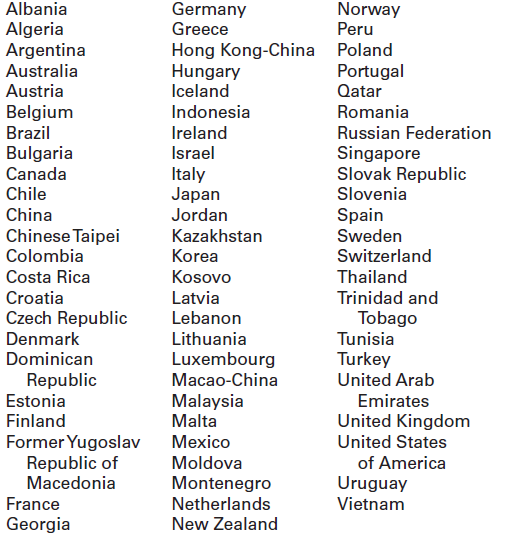
*As of April 2016.
Where do I find more information?
Visit the PISA website at http://nces.ed.gov/surveys/pisa.
For additional questions about PISA 2018, contact the PISA U.S. home office at 1-888-638-2597 or email [email protected].
The National Center for Education Statistics (NCES), within the U.S. Department of Education, conducts the Program for International Student Assessment (PISA) in the United States as authorized by the Education Sciences Reform Act of 2002 (20 U.S.C., § 9543). Your responses are protected by federal statute (20 U.S.C., § 9573) and may be used only for statistical purposes and may not be disclosed, or used, in identifiable form for any other purpose except as required by law. The U.S. Office of Management and Budget has approved this data collection under OMB #1850-0755.
PISA
2018 Field Test FAQ for school administrators - Front Page
Program for International Student Assessment
FREQUENTLY ASKED QUESTIONS
PISA 2018 Field Test (Spring 2017)
“PISA’s benefit is that it focuses more on the application of information than
the memorization of information. Internationally, education focuses on deeper
learning. Similarly, PISA reflects that international method and focuses on
deeper learning rather than wider.”
High School Principal, PISA 2009 Participant
PISA is an international assessment of 15-year-old students that measures how well students apply their knowledge and skills to solve problems related to science, reading, and mathematics in real-life contexts. In the PISA 2018 field test, students will be assessed in reading, mathematics, science, global competence, financial literacy, or some combination of these subjects.
What is the field test for?
Field tests are a critical part of the development of test questions for international assessments like PISA. Field tests (small-scale, trial runs of an assessment) allow assessment developers to try out new questions to determine their performance when administered to students around the world. The results of the U.S. field test will help assessment developers to eliminate wording or topics that would put U.S. students at a disadvantage relative to students in other countries. The field test also ensures that data collection procedures are done efficiently and correctly.
Why was my school selected for participation?
Your school was randomly selected so that the overall U.S. field test sample would be representative of the overall U.S. school population. Field-testing on a diverse sample of students from a variety of schools, locations, and backgrounds ensures that the assessment wording and concepts are not regionally, culturally, or socially biased.
Why should my school and students participate?
PISA informs national discussions about education as well as international competitiveness. By participating, students ensure fairness in the questions that will be used in the main study in 2018. Field-testing the assessment questions will identify wording and concepts that could disadvantage U.S. students in the main study. Students’ efforts in the field test ensure that the achievement of our nation’s 15-year-olds is accurately and fairly reported.
Is it possible that my school will be selected for the main study as well as the field test?
It is extremely unlikely that a school selected for the field test will be selected for the main study.
Will all of our 15-year-old students be asked to participate?
Probably not. In each school, all 15-year-olds will have an equal chance of selection, and selected students will be part of a nationally representative sample. Student selection is not based on any student characteristic other than being 15 years old. Up to 50 students will be selected to participate. Only in very small schools will the school sample likely include all 15-year-olds. In addition, some students with disabilities or limited English proficiency may be offered a limited set of accommodations to enable their participation; otherwise, they may be excused from the assessment.
PISA 2018 Field Test FAQ for
school administrators- Back Page
Who conducts the PISA assessment?
The entire assessment process will be undertaken by trained staff from Westat, a research organization under contract to the U.S. Department of Education’s National Center for Education Statistics (NCES). NCES conducts PISA under authorization in the Education Sciences Reform Act of 2002 (20 U.S.C., § 9543) and approval of the U.S. Office of Management and Budget under OMB #1850-0755. In compliance with standard protocols, Westat field staff undergoes FBI background checks.
How are teacher and school questionnaires administered?
The teacher and school questionnaires are both administered online from a secure website. The online teacher questionnaire takes approximately 45 minutes to complete and asks about teachers’ education and teaching experience. The school questionnaire, which looks at school characteristics such as enrollment and school practices, is also online and takes about 45 minutes to complete.
Will all of our teachers be asked to participate?
From a listing of teachers in the school, up to 25 teachers (10 English or English Language Arts and 15 non-English subject areas) will be asked to participate in the online teacher questionnaire.
Do teachers or other school staff need to help administer the assessment?
No. Westat field staff will visit the school on the day of the assessment, bringing with them all the materials required, and they will handle the entire administration of the assessment. Field staff will also bring all of the necessary computer equipment for the computer-based assessments. There is no requirement for school resources such as school computers or access to the internet. All that is required is adequate space to set up the equipment and assess the students.
When will the field test be conducted?
The field test will be conducted between April 3 and May 12, 2017. Westat will work with schools to identify an assessment date convenient for the school in that time period.
Where will the field test be conducted?
The assessment will be conducted in the schools that are selected to participate. The assessment space needs to be able to accommodate the students and the computer equipment.
How long does the field test take?
Students will take a computer-based assessment. This approximately 3-hour session includes time for instructions, the assessment, and a brief questionnaire that students complete about themselves.
What will happen with the collected data?
The field test data will be used to evaluate whether the assessment fairly and accurately measures students’ knowledge and skills in all participating countries. By law, the data provided by schools, staff, and students and may be used only for statistical purposes and may not be disclosed, or used, in identifiable form for any other purpose except as required by law (20 U.S. Code, Section 9573). Reports of the findings from the field test will not identify participating districts, schools, students, or individual staff. Individual responses will be combined with those from other participants to produce summary statistics and reports.
Where can I find more information?
Visit the PISA website at http://nces.ed.gov/surveys/pisa. For additional questions about PISA 2018, contact the PISA U.S. home office at 1-888-638-2597 or email [email protected].

PISA 2018 Field Test FAQ for Teachers
Program for International Student Assessment
FREQUENTLY ASKED QUESTIONS
Information for Teachers
What is PISA?
The Program for International Student Assessment (PISA) is an international assessment of 15-year-old students, conducted every three years, that measures how well students apply their knowledge and skills in science, reading, and mathematics. Approximately 70 countries and education systems, including the United States, will participate in PISA 2018. PISA is coordinated by the Organization for Economic Cooperation and Development (OECD) and conducted in the United States by the National Center for Education Statistics (NCES) within the U.S. Department of Education.
PISA provides a unique opportunity for the United States to understand its educational standing in comparison to other nations. Through participating in PISA, schools, teachers, and students contribute to the improvement of education. PISA can help us identify U.S. students’ strengths and weaknesses in these subjects and help us learn about successful policies and practices in other countries.
What role do teachers have in PISA?
Teachers are asked to complete an online questionnaire. This gives you an opportunity to provide information that is critical to understanding student performance as well as to voice your perspectives on teaching and learning at your school. The teacher questionnaire asks about your background and teaching experience, the student body, and your views on school policies and evaluation.
How was I selected to take the PISA teacher questionnaire?
The PISA school coordinator in your school (the person designated by your school principal to communicate with PISA staff) provided a list of all teachers eligible to teach tenth-grade students in your school. You are one of about 25 teachers from your school who were selected to participate. Your participation in PISA is vital to reaching a high response rate.
How long will it take to complete the PISA teacher questionnaire?
The teacher questionnaire will take approximately 30 minutes to complete online, and you do not have to complete it all in a single session. The online software automatically saves your responses to each question as you navigate through the questionnaire so that if you wish to complete the questionnaire later, you may pick up right where you left off. Each teacher will be offered $25 for completing the online questionnaire.
How can I access the PISA teacher questionnaire?
To access the teacher questionnaire (https://www.mypisausa.com/teacherquestionnaire), you will need to have an internet connection, a suitable internet browser (see list below), and your login credentials. You will be emailed a unique hyperlink that you can click on to access the questionnaire directly. The PISA staff are ready to work with you to make access and completion of the teacher questionnaire as easy and efficient as possible.
The following browsers are supported by PISA and can be downloaded for free if you do not already have them installed on the computer:
• Firefox: Version 19 and above
• Internet Explorer: Version 8 and above
• Google Chrome: Version 25 and above
• Safari (Mac version): versions 6 and above
What is done with the information you collect from me?
Your responses to the PISA teacher questionnaire will be combined with those from other participating teachers across the United States to produce summary statistics and reports. By law, data provided by schools, staff, and students may be used only for statistical purposes and may not be disclosed, or used, in identifiable form for any other purpose except as required by law [Education Sciences Reform Act of 2002 (ESRA 2002), 20 U.S. Code, Section 9573]. The U.S. Office of Management and Budget has approved this data collection under OMB # 1850-0755. Reports of the findings will not identify participating districts, students, or individual staff. For a recent example of how PISA data are reported, please visit http://nces.ed.gov/pubs2014/2014024rev.pdf.
Where can I go for help or technical support?
If you have any questions or experience any difficulties, please contact the PISA U.S. home office at
1-888-638-2597 or email [email protected].
For more information on PISA, including results from previous data collections, please visit http://nces.ed.gov/surveys/pisa.

PISA 2018 Field Test FAQ for Students
Program for International Student Assessment
FREQUENTLY ASKED QUESTIONS
Information for Students
What is PISA?
The Program for International Student Assessment (PISA) is an international assessment of 15-year-old students that measures how well students apply their knowledge and skills in solving problems in reading, mathematics, science, financial literacy, and global competence. Conducted every three years, PISA presents problems that students are likely to encounter in the real world. In spring of 2017, students like you from more than 70 countries and education systems, including the United States, will participate in the PISA field test.
Why should I participate in PISA?
You are one of about 50 students in your school who have been selected to participate in PISA. Participation in PISA is voluntary, but, you are one of a select few in your school and so your participation is very important. If you participate in PISA you will…
• Receive a certificate for 4-hours of volunteer service from the U.S. Department of Education.
• Represent students like you across the country.
Only 3,000 students will have the unique opportunity to participate in PISA field test across the United States. How often do you get to represent your country? Participating in PISA is a national service. You can have an impact on the bigger picture of education in the United States and around the world.
What subjects are assessed in PISA?
Each student participating in PISA will be assessed in various combinations of the following subjects: reading, mathematics, science, financial literacy, or global competence. Global competence is new for PISA 2018 and encompasses the knowledge, skills and attitudes needed to be successful in achieving your educational goals, employment paths, and community living within an increasing intercultural, diverse world.
How long does PISA take?
The PISA assessment takes approximately 3 hours to complete. This includes time for instructions, the assessment, and a brief survey about you.
How did my school get selected to take PISA?
The schools that participate in PISA in the United States are randomly selected from a list of all schools in the country that enroll 15-year-old students. This is done to ensure that U.S. participants accurately represent the entire population of 15-year-old students in the United States and not just particular types of schools or groups of students.
How did I get selected to take PISA?
The only criteria for being eligible to be selected for PISA are being 15 years old and in grade 7 or higher. From a list of all 15-year-old students provided by your school, up to 50 students are randomly selected to participate. Every 15-year-old student enrolled in a PISA selected school has an equal chance of being selected. Students in other countries are selected in the same way to make sure each country is fairly represented and no country is advantaged or disadvantaged because of the types of schools or groups of students selected.
What types of questions will I see on PISA?
PISA questions assess the knowledge and skills you have learned both in and out of school, based on situations you may encounter in real life. Some PISA questions require that you select from a set of provided answers; other PISA questions require that you write out your response. PISA is administered on computer and many of the items are interactive, where you manipulate different pieces of information. To try PISA items on your own, please visit http://nces.ed.gov/surveys/pisa/items_cba.asp.
What is done with the information you collect from me?
PISA is not designed to produce individual test scores and your individual performance is not shared with your teachers, school, or district in any way. Student responses are combined with other student responses and are only used for statistical purposes. The data collected for the field test will be used to evaluate the fairness of items for the main study, to be conducted in 2018. By law, data provided by schools, staff, and students and may be used only for statistical purposes and may not be disclosed, or used, in identifiable form for any other purpose except as required by law (20 U.S. Code, Section 9573).
Where can I find more information?
Visit the PISA website at http://nces.ed.gov/surveys/pisa. For additional questions about PISA, contact the PISA U.S. home office at 1-888-638-2597 or email [email protected].
PISA
2018 Timeline of Activities – Field Test

|
Nov–Dec 2016 |
Jan–Mar 2017 Pre-assessment Contact |
April–May 2017 Assessment Visit |
Benefits |
Principal and Teachers |
|
|
|
|
School Coordinator |
|
|
|
|
Students |
|
|
|
|
PISA Staff |
|
|
|
|
Find Out More |
||||

Teacher Invite Email for Field Trial
Month, Day, 2017
Dear [Teacher Name]:
The United States is once again participating in an important international study: the Program for International Student Assessment (PISA). PISA is the largest international assessment of education in the world, with more than 70 countries and education systems participating in each cycle. Every three years, PISA provides comparative information on the performance of U.S. 15-year-old students in science, reading, and mathematics with 15-year-old students in other countries.
Your school is one of 70 schools across the United States that are taking part in the PISA field test and you’ve been selected to participate by completing an online teacher questionnaire about the courses you teach, your teacher training and education, and your views on teaching.
The questionnaire takes about 45 minutes to complete. This information, combined with responses from school principals and students, helps to provide a more complete understanding of student achievement and contexts for learning. Your responses are not linked to student achievement and will not be shared with the school or district.
You will receive $25 for completing the questionnaire, if allowed by your school’s policy. Use the provided link and unique account information below to complete your questionnaire.
Link:
http://portal.mypisausa.com/TeacherQuestionnaire
Username:
Password:
The National Center for Education Statistics (NCES), within the U.S. Department of Education, conducts PISA in the United States as authorized by the Education Sciences Reform Act of 2002 (20 U.S.C., § 9543). Your responses are protected by federal statute (20 U.S.C., § 9573) and may be used only for statistical purposes and may not be disclosed, or used, in identifiable form for any other purpose except as required by law. The U.S. Office of Management and Budget has approved the data collection under OMB #1850-0755. For more detailed information, please see the attached FAQ.
If you have any questions, please do not hesitate to call 1-888-638-2597 or send an email to [email protected]. You may also get more information about this study by visiting the PISA website at http://nces.ed.gov/surveys/pisa.
Thank you for your time and for supporting this important international study.
Sincerely,
The PISA USA Team

School Coordinator Email announcing E-Filing for Field Trial
Subject: PISA E-Filing open
Attachment: PISA 2018 Field Trial E-Filing Instructions
Dear School Coordinator:
Welcome and thank you for your efforts as the school coordinator for the Program for International Student Assessment (PISA) 2018 at your school!
In order to sample students and teachers for the PISA field trial, we need a list of eligible students and teachers. The deadline for student and teacher lists to be submitted for sampling is Month Day, 2017. Please upload your school’s lists as soon as possible so that sampled teachers, students, and their parents can be notified well in advance of the assessment day.
Detailed instructions on submitting your lists to PISA are included in the enclosed document titled PISA 2018 Field Trial E-Filing Instructions.
If you have any questions about the instructions, please contact the PISA Help Desk at [email protected] or by calling 1-888-638-2597. The e-filing instructions are also posted on the MyPISAUSA website (www.mypisausa.com).
Sincerely,
The PISA USA Team

Instructions for School Coordinators to E-file student and teacher
lists (from 2015)
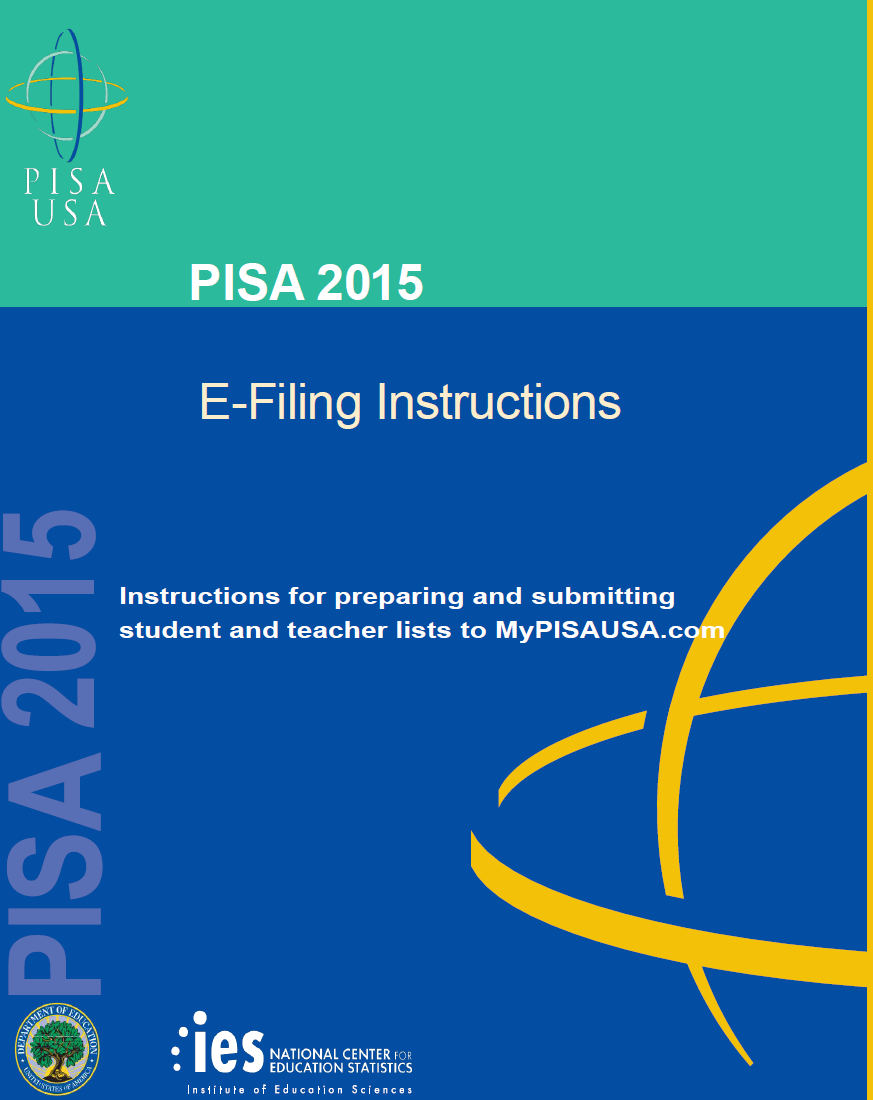
Table of Contents
1. PREPARE ELECTRONIC STUDENT FILE (E-FILE) ........................................................ 1
Steps for preparing an Electronic Student File (E-File) ........................................................................ 1
Step 1: Identify ALL students at your school who meet the eligibility criteria ...................................... 1
Step 2: List each of the eligible students ................................................................................................ 1
Submitting your Electronic Student File ............................................................................................ 2
Student E-File Step 1: Upload your file. ..................................................................................................... 3
Student E-File Step 2: Identify your column contents .............................................................................. 4
Student E-File Step 3: Match your values to PISA codes. .......................................................................... 5
Student E-File Step 4: Verify your E-File.. ............................................................................................... 6
E-File Complete! . .................................................................................................................................... 7
2. PREPARE ELECTRONIC TEACHER FILE (E-FILE) ....................................................... 8
Steps for preparing an Electronic Teacher File (E-File) ....................................................................... 8
Step 1: Identify ALL teachers at your school who are eligible to teach 10th grade .................................. 8
Step 2: List each of the eligible teachers . ................................................................................................. 8
Submitting your Electronic Teacher File ............................................................................................ 9
Teacher E-File Step 1: Upload your file. ................................................................................................. 10
Teacher E-File Step 2: Identify your column contents. ................................................................................ 11
Teacher E-File Step 3: Match your values to PISA codes. ............................................................................ 12
Teacher E-File Step 4: Verify your E-File . .................................................................................................... 13
E-File Complete!. .................................................................................................................................... 14
The National Center for Education Statistics (NCES), within the U.S. Department of Education, conducts the Program for International Student Assessment (PISA) in the United States as authorized by the Education Sciences Reform Act of 2002 (20 U.S.C., § 9543). Your responses are protected by federal statute (20 U.S.C., § 9573) and may be used only for statistical purposes and may not be disclosed, or used, in identifiable form for any other purpose except as required by law.
According to the Paperwork Reduction Act of 1995, no persons are required to respond to a collection of information unless such collection displays a valid OMB control number. The valid OMB control number for this voluntary survey is 1850-0755. The time required to complete this survey is estimated to average no more than 60 minutes per response, including the time to review instructions, search existing data resources, gather the data needed, and complete and review the survey. If you have any comments concerning the accuracy of the time estimate, suggestions for improving this survey, or any comments or concerns regarding the status of your individual submission of this survey, please write to: Program for International Student Assessment (PISA), National Center for Education Statistics, Potomac Center Plaza, 550 12th Street, SW, Washington, DC 20202.
OMB No. 1850-0755, Approval Expires xx/xx/2019.
 1.
Prepare
Electronic
Student
File
(E-File)
1.
Prepare
Electronic
Student
File
(E-File)
Steps for preparing an Electronic Student File (E-File)
Step 1: Identify ALL students at your school who meet the eligibility criteria
Criteria for PISA student eligibility are:
Enrolled in Grade 7 or higher, AND
Born between July 1, 1999 and June 30, 2000.
PISA needs accurate information about all students at your school who meet the above criteria for student eligibility. Include all students, even those students who typically may be excluded from other testing programs, such as students with IEPs or 504 plans (SD), English language learners (ELL), or students with limited English proficiency (LEP). A small number of these students may be unable to complete the PISA assessment. Do not include students who are known to be withdrawn on your list. All other eligible students must be added to your list of students.
Step 2: List each of the eligible students along with their demographic information (see
Figure 1 below for an example)
Using the electronic listing form template provided on the MyPISAUSA.com website (www.MyPISAUSA.com), list students in your school who are eligible for PISA along with their demographic information.
Student first name
Student middle name (not required)
Student last name
Grade in school (Grade 7 – Grade 12 as applicable)
Month of birth (M or MM; must be submitted in numeric format, not text)
Year of birth (YYYY: 1998)
Sex (1 = Female; 2 = Male)
Figure 1: Example of Electronic Student File
Student First Name |
Student Last Name |
Grade |
Month of Birth |
Year of Birth |
Sex |
Ted |
Brooks |
10 |
12 |
1999 |
2 |
Jeffrey |
Jenkins |
10 |
11 |
1999 |
2 |
Rose |
Matthews |
10 |
12 |
1999 |
1 |
Jennifer |
Trader |
9 |
5 |
2000 |
1 |
José |
Rodriguez |
9 |
5 |
2000 |
2 |
Roy |
Zastrow |
10 |
11 |
1999 |
2 |
Sam |
Walker |
11 |
7 |
1999 |
2 |
Julie |
Walters |
9 |
6 |
1999 |
1 |
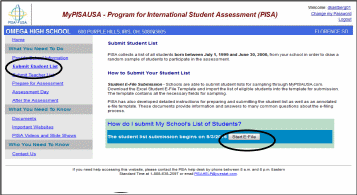 Submitting
Your
Electronic
Student
File
Submitting
Your
Electronic
Student
File
After you have created and saved your E-File, proceed to MyPISAUSA. Once you have logged in, click the “Submit Student List” link on the left side of the page. Then click the START E-FILE button at the bottom of the page.
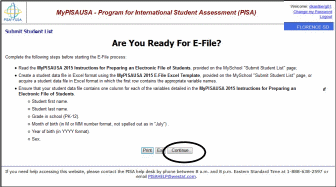 The
next
page
will
help
you
verify
if
you
are
ready
to
E-File.
Use
the
checklist
to
ensure
that
your
student
listing
meets
the
needed
criteria.
Click
CONTINUE
to
move
to
the
next
screen.
The
next
page
will
help
you
verify
if
you
are
ready
to
E-File.
Use
the
checklist
to
ensure
that
your
student
listing
meets
the
needed
criteria.
Click
CONTINUE
to
move
to
the
next
screen.
Student E-File Step 1. Begin the E-Filing process by certifying the date on which your E-File data is accurate. Enter this date in the specified box and indicate if your file contains column headers using the drop-down menu.
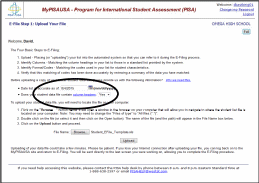
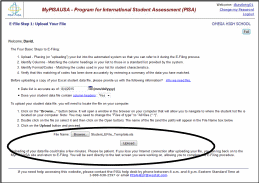 Next,
upload
your
electronic
student
file
by
clicking
the
BROWSE
button
at
the
bottom
of
the
page
to
locate
it
on
your
computer.
Locate
your
file
and
select
it.
Click
the
UPLOAD
button.
Next,
upload
your
electronic
student
file
by
clicking
the
BROWSE
button
at
the
bottom
of
the
page
to
locate
it
on
your
computer.
Locate
your
file
and
select
it.
Click
the
UPLOAD
button.
Student E-File Step 2. The column headings in your file are shown in rows on the left side of the page. In each row, for each heading on the left, click on the down arrow next to the words in the table that read "Column contains..." on the right. If there is no appropriate description in the drop- down list for your column heading, select N/A. The essential information that must be reflected in the columns on the student list is
grade,
student first name,
student last name,
month of birth,
year of birth, and
sex.
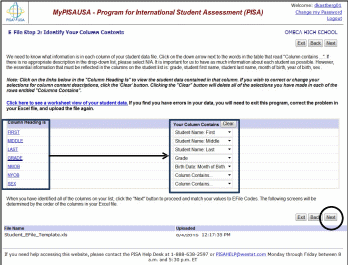 When
you
have
identified
each
column
heading,
click
NEXT.
When
you
have
identified
each
column
heading,
click
NEXT.
Student E-File Step 3. The next step is to identify your column contents by mapping the values
from your file to the “PISA Codes.” For each grade value on each row, match the grade value in
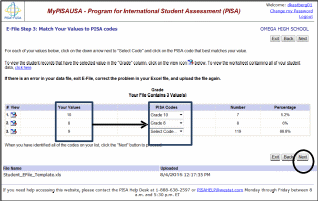 your
file
shown
on
the
left
with
the
grade
values
in
the
drop-down
list
on
the
right.
When
you
have
identified
each
grade
value,
click
NEXT.
your
file
shown
on
the
left
with
the
grade
values
in
the
drop-down
list
on
the
right.
When
you
have
identified
each
grade
value,
click
NEXT.
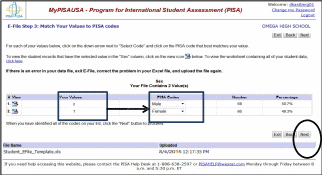 Next,
match
your
values
for
student
sex
following
the
same
procedure
of
selecting
an
appropriate
code
from
the
drop
down
list
that
match
your
values.
When
you
have
identified
each
sex
value,
click
NEXT.
Next,
match
your
values
for
student
sex
following
the
same
procedure
of
selecting
an
appropriate
code
from
the
drop
down
list
that
match
your
values.
When
you
have
identified
each
sex
value,
click
NEXT.
Student E-File Step 4. Finally, you will see a table that summarizes your student data for grade and student sex. Record that the information is correct and click SUBMIT.
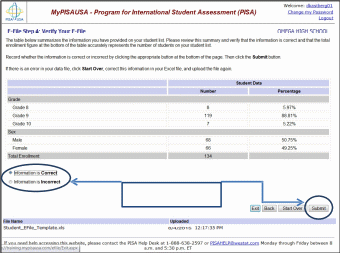
Check that your information is correct and submit.
E-File Complete! Your E-File is complete and your student list has been submitted.
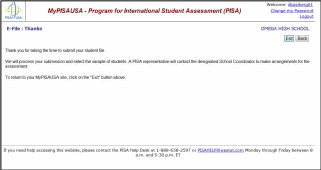
IMPORTANT! If at any point you have any difficulties with this process, please do not hesitate to contact the PISA Help Desk for assistance at 1-888-638-2597.
Please Note: You must submit both your student and teacher lists before your school's sample is processed.
 2.
Prepare
Electronic
Teacher
File
(E-File)
2.
Prepare
Electronic
Teacher
File
(E-File)
Steps for preparing an Electronic Teacher File (E-File)
Step 1: Identify ALL teachers at your school who are eligible to teach 10th grade
Criteria for PISA teacher eligibility are:
All teachers eligible to teach 10th grade
PISA needs accurate information about all teachers at your school who are eligible to teach 10th grade students, whether or not they currently have tenth graders in their classes.
Step 2: List each of the eligible teachers along with their email address, whether they currently teach 10th grade, and whether or not they teach science.
Using the electronic listing form template provided on the MyPISAUSA.com website (www.MyPISAUSA.com), list teachers in your school who are eligible for PISA along with their other necessary information.
Teacher first name
Teacher middle name (not required)
Teacher last name
Whether or not they currently teach 10th grade (20 indicates yes, they teach 10th grade; 30
indicates they do not)
Whether or not they currently teach a science course (4 indicates yes, they currently teach
science; 5 indicates they do not)
Email address (this is needed to deliver their log in credentials electronically)
Figure 2: Example of Electronic Teacher File
Teacher First Name |
Teacher Last Name |
|
Teaches 10th Grade? (20 = Yes, 30 = No) |
Teaches Science? (4 = Yes, 5 = No) |
Tom |
Brooks |
20 |
4 |
|
John |
Jenkins |
30 |
5 |
|
Beth |
Matthews |
20 |
5 |
|
Michelle |
Trader |
20 |
5 |
|
Jaime |
Rodriguez |
30 |
5 |
|
Ron |
Zastrow |
30 |
4 |
|
Sarah |
Walker |
20 |
4 |
|
Julie |
Walters |
20 |
4 |
Submitting your Electronic Teacher File
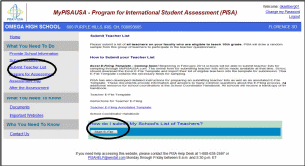 After
you
have
created
and
saved
your
E-File,
proceed
to
MyPISAUSA.
Once
you
have
logged
in,
click
the
“Submit
Teacher
List”
link
on
the
left
side
of
the
page.
Then,
click
the
START
E-FILE
button
at
the
bottom
of
the
page.
After
you
have
created
and
saved
your
E-File,
proceed
to
MyPISAUSA.
Once
you
have
logged
in,
click
the
“Submit
Teacher
List”
link
on
the
left
side
of
the
page.
Then,
click
the
START
E-FILE
button
at
the
bottom
of
the
page.
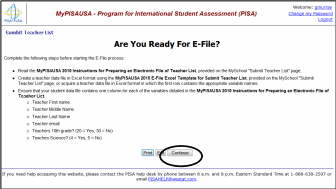 The
next
page
will
help
you
verify
if
you
are
ready
to
E-File.
Use
the
checklist
to
ensure
that
your
teacher
list
meets
the
needed
criteria.
Click
CONTINUE
to
move
to
the
next
screen.
The
next
page
will
help
you
verify
if
you
are
ready
to
E-File.
Use
the
checklist
to
ensure
that
your
teacher
list
meets
the
needed
criteria.
Click
CONTINUE
to
move
to
the
next
screen.
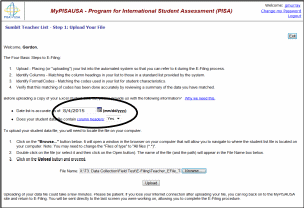 Teacher
E-File
Step
1.
Begin
the
E-Filing
process
by
certifying
the
date
on
which
your
E-File
data
was
created,
which
is
typically
the
date
on
which
the
list
is
verified
as
accurate.
Enter
this
date
in
the
specified
box
and
indicate
if
your
file
contains
column
headers
using
the
drop-down
menu.
Teacher
E-File
Step
1.
Begin
the
E-Filing
process
by
certifying
the
date
on
which
your
E-File
data
was
created,
which
is
typically
the
date
on
which
the
list
is
verified
as
accurate.
Enter
this
date
in
the
specified
box
and
indicate
if
your
file
contains
column
headers
using
the
drop-down
menu.
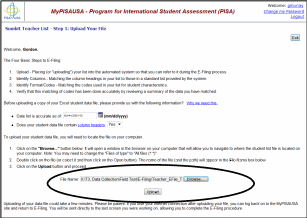 Next,
upload
your
electronic
teacher
file
by
clicking
the
BROWSE
button
at
the
bottom
of
the
page
to
locate
it
on
your
computer.
Locate
your
file
and
select
it.
Click
the
UPLOAD
button.
Next,
upload
your
electronic
teacher
file
by
clicking
the
BROWSE
button
at
the
bottom
of
the
page
to
locate
it
on
your
computer.
Locate
your
file
and
select
it.
Click
the
UPLOAD
button.
Teacher E-File Step 2. The column headings in your file are shown in rows on the left side of the page. In each row, for each heading on the left, click on the down arrow next to the words in the table that read "Column contains..." on the right. This process is called column mapping. If there is no appropriate description in the drop-down list for your column heading, select N/A (see image below). The essential information that must be reflected in the columns on the teacher list is:
teacher first name
teacher last name
teacher email
teaches 10th grade? (20 = Yes, 30 = No)
teaches science? (4 = Yes, 5 = No)
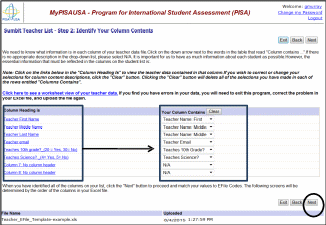 When
you
have
identified
each
column
heading,
click
NEXT.
When
you
have
identified
each
column
heading,
click
NEXT.
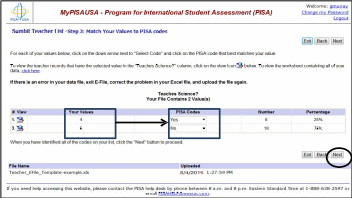 Teacher
E-File
Step
3.
The
next
step
is
to
identify
your
column
contents
by
mapping
the
values
from
your
file
to
the
“PISA
Codes.”
The
first
column
order
depends
on
your
file,
but
you
will
likely
see
“Teaches
10th
Grade?”
first.
The
PISA
codes
are
“Yes”
or
“No.”
These
correspond
to
values
of
20
or
30,
respectively.
So,
for
each
of
your
values,
match
the
value
from
your
file
to
the
“PISA
Codes”
in
the
drop-down
list
on
the
right.
When
you
have
mapped
each
value,
click
NEXT.
Teacher
E-File
Step
3.
The
next
step
is
to
identify
your
column
contents
by
mapping
the
values
from
your
file
to
the
“PISA
Codes.”
The
first
column
order
depends
on
your
file,
but
you
will
likely
see
“Teaches
10th
Grade?”
first.
The
PISA
codes
are
“Yes”
or
“No.”
These
correspond
to
values
of
20
or
30,
respectively.
So,
for
each
of
your
values,
match
the
value
from
your
file
to
the
“PISA
Codes”
in
the
drop-down
list
on
the
right.
When
you
have
mapped
each
value,
click
NEXT.
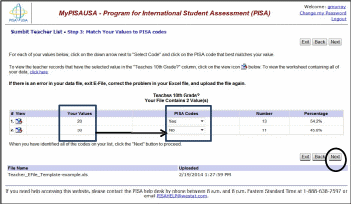
Next, identify your column contents for the “Teaches Science?” column following the same procedure of selecting an appropriate code from the drop down list that matches your values. When you have identified each column heading, click NEXT.
Teacher E-File Step 4. Finally, you will see a table that summarizes your teacher data for “Teaches 10th Grade?” and “Teaches Science?” Check to make sure the data are correct, and select “information correct” and click SUBMIT. If the data are not correct, click “Start Over,” correct your Excel file, and upload the file again.
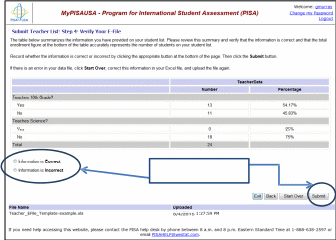
Check that your information is correct and submit.
E-File Complete! Your E-File is complete and your teacher list has been submitted.
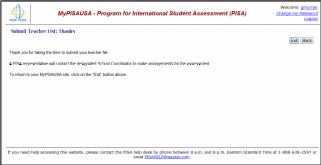
IMPORTANT! If at any point you have any difficulties with this process, please do not hesitate to contact the PISA Help Desk for assistance at 1-888-638-2597.
Please Note: You must submit your student and teacher lists before your school's sample is processed.
Appendix B: PISA 2018 Field Test Consent Letters and Supporting Materials
Sample Field Test Notification Letter, PISA 31
Sample Implicit Consent Letter, PISA 32
Sample Field Test Notification Letter, PISA
SCHOOL LETTERHEAD
Dear Parent or Guardian,
This letter is to inform you about an important international study of student learning being conducted in our school this spring. This study is called the Program for International Student Assessment, or PISA. PISA provides important information for internationally benchmarking performance in reading, mathematics, and science of 15-year-old students in the United States against top countries around the world.
Each time the study is conducted, new test questions need to be developed and tested to ensure that those questions accurately measure the knowledge and skills of students. In spring 2017, new questions will be tested in approximately 70 schools in the United States. This field test will allow test developers to modify or delete questions that are not working effectively and ensure that PISA is valid and fair to all U.S. students.
Our school has accepted an invitation from the National Center for Education Statistics (NCES) within the U.S. Department of Education to participate in the PISA field test. A select few of our 15-year-old students, along with your teenager, will take part in this study. The enclosed summary sheet provides some background on PISA, explains what is involved for each student selected to participate in the study, and gives a contact phone number and email address where you can find answers to any questions you might have.
To have an accurate picture of what U.S. 15-year-old students can do, it is important that each student selected takes part in the study. The PISA assessment is taken on a computer. Also, students will be asked to complete a brief questionnaire. I urge you to support this effort by encouraging your teenager to take part; however, participation in this study is entirely voluntary. Previous experience suggests that students enjoy taking part, and all participating students will receive $25 and a certificate from the U.S. Department of Education for 4 hours of volunteer service.
The information provided by students will not be shared with the school. NCES is authorized to conduct PISA under the Education Sciences Reform Act of 2002 (ESRA 2002, 20 U.S.C., § 9543). The data provided by schools, staff, and students and may be used only for statistical purposes and may not be disclosed, or used, in identifiable form for any other purpose except as required by law (20 U.S.C., § 9573). Students and schools are never identified in any reports. All reported statistics refer to the United States as a whole.
Thank you for taking the time to learn about this important study.
Sincerely,
Enclosures:
Facts for Parents about the PISA Field Test
Sample Implicit Consent Letter for Parents, PISA 2018 Field Trial
SCHOOL LETTERHEAD
Dear Parent or Guardian,
This letter is to inform you about an important international study of student learning being conducted in our school this spring. This study is called the Program for International Student Assessment, or PISA. PISA provides important information for internationally benchmarking performance in reading, mathematics, and science of 15-year-old students in the United States against top countries around the world.
Each time the study is conducted, new test questions need to be developed and tested to ensure that those questions accurately measure the knowledge and skills of students. In spring 2017, new questions will be tested in approximately 70 schools in the United States. This field test will allow test developers to modify or delete questions that are not working effectively and ensure that PISA is valid and fair to all U.S. students.
Our school has accepted an invitation from the National Center for Education Statistics (NCES), U.S. Department of Education, to participate in the PISA field test. A select few of our 15-year-old students, along with your teenager, will take part in this study. The enclosed summary sheet provides some background to PISA, explains what is involved for each student selected to participate in the study, and gives a contact phone number and email address where you can find answers to any questions you might have.
To have an accurate picture of what U.S. 15-year-old students can do, it is important that each student selected takes part in the study. Some students will try out questions administered on a computer while other students will try out questions using paper and pencil. Also, students will be asked to complete a brief questionnaire about themselves. I urge you to support this effort by encouraging your teenager to take part; however, participation in this study is entirely voluntary. Previous experience suggests that students enjoy taking part, and all participating students will receive $25 and a certificate from the U.S. Department of Education for 4 hours of volunteer service.
The information provided by students will not be shared with the school. NCES is authorized to conduct PISA under the Education Sciences Reform Act of 2002 (ESRA 2002, 20 U.S.C., § 9543). The data provided by schools, staff, and students and may be used only for statistical purposes and may not be disclosed, or used, in identifiable form for any other purpose except as required by law (20 U.S.C., § 9573). Students and schools are never identified in any reports. All reported statistics refer to the United States as a whole.
If you have an objection to your teenager joining in the PISA activities, please let us know by completing the attached consent form and returning it to the school.
Thank you for taking the time to learn about this important study.
Sincerely,
Enclosures:
Facts for Parents About the PISA Field Test
Parent/Guardian Consent Form
PISA Implicit Consent Form
Program for International Student Assessment (PISA)
Field Test
Parent/Guardian Consent Form
Your teenager has been asked to participate in a field test of an international study of student learning called the Program for International Student Assessment (PISA). Each student who participates will receive $25 and a volunteer service certificate of 4 hours from the U.S. Department of Education. This assessment will be administered by a team of researchers from Westat, who are operating under contract to the National Center for Education Statistics within the U. S. Department of Education. In spring 2017, new questions will be tested in approximately 70 schools in the United States. This field test will allow test developers to modify or delete questions that are not working effectively and ensure that PISA is valid and fair to all U.S. students.
If you grant permission for your teenager to participate in the PISA field test, you do not need to return this form.
If you do not consent to your teenager’s participation in the PISA field test, please return this form to your teenager’s school as soon as possible.
I do not grant permission for my teenager, _______________________________, to participate in the Program for International Student Assessment Field Test.
__________________________________________________________________
(Signature of parent or guardian)
Date of signature: _______/_______/____________
PLEASE PRINT:
Student name: _____________________________________________
School name: ______________________________________________
FOR OFFICE USE ONLY:
Student ID: ________________________________________________
Sample Explicit Consent Letter for Parents--PISA2018 Field Trial
SCHOOL LETTERHEAD
Dear Parent or Guardian,
This letter is to inform you about an important international study of student learning being conducted in our school this spring. This study is called the Program for International Student Assessment, or PISA. PISA provides important information for internationally benchmarking performance in reading, mathematics, and science of 15-year-old students in the United States against top countries around the world.
Each time the study is conducted, new test questions need to be developed and tested to ensure that those questions accurately measure the knowledge and skills of students. In spring 2017, new questions will be tested in approximately 70 schools in the United States. This field test will allow test developers to modify or delete questions that are not working effectively and ensure that PISA is valid and fair to all U.S. students.
Our school has accepted an invitation from the National Center for Education Statistics (NCES), U.S. Department of Education, to participate in the PISA field test. A select few of our 15-year-old students, along with your teenager, will take part in this study. The enclosed summary sheet provides some background to PISA, explains what is involved for each student selected to participate in the study, and gives a contact phone number and email address where you can find answers to any questions you might have.
To have an accurate picture of what U.S. 15-year-old students can do, it is important that each student selected takes part in the study. Some students will try out questions administered on a computer while other students will try out questions using paper and pencil. Also, students will be asked to complete a brief questionnaire about themselves. I urge you to support this effort by encouraging your teenager to take part; however, participation in this study is entirely voluntary. Previous experience suggests that students enjoy taking part, and all participating students will receive $25 and a certificate from the U.S. Department of Education for 4 hours of volunteer service.
The information provided by students will not be shared with the school. NCES is authorized to conduct PISA under the Education Sciences Reform Act of 2002 (ESRA 2002, 20 U.S.C., § 9543). The data provided by schools, staff, and students and may be used only for statistical purposes and may not be disclosed, or used, in identifiable form for any other purpose except as required by law (20 U.S.C., § 9573). Students and schools are never identified in any reports. All reported statistics refer to the United States as a whole.
Before we can allow your teenager to join in the PISA field test we must have your written consent. Please complete the attached form and return it to the school.
Thank you for taking the time to learn about this important study and considering your teenager’s participation in it.
Sincerely,
Enclosures:
Facts for Parents About the PISA Field Test
Parent/Guardian Consent Form
PISA Explicit Consent Form for Parents—PISA 2018 Field Trial
Program for International Student Assessment (PISA)
Field Test
Parent/Guardian Consent Form
Your teenager has been asked to participate in a field test of an international study of student learning called the Program for International Student Assessment (PISA). Each student who participates will receive $25 and a volunteer service certificate of 4 hours from the U.S. Department of Education. This assessment will be administered by a team of researchers from Westat who are operating under contract on behalf of the National Center for Education Statistics within the U. S. Department of Education. In spring 2017, new questions will be tested in approximately 70 schools in the United States. This field test will allow test developers to modify or delete questions that are not working effectively and ensure that PISA is valid and fair to all U.S. students.

Yes, I grant permission for my teenager to participate in the PISA field test.

No, I do not grant permission for my teenager to participate in the PISA field test.
__________________________________________________________________
(Signature of parent or guardian)
Date of signature: _______/_______/____________
PLEASE PRINT:
Student name: _____________________________________________
School name: ______________________________________________
FOR OFFICE USE ONLY:
Student ID: ________________________________________________
FAQ for Parents About the Field Test—PISA 2018 Field Trial
Facts for Parents
About the PISA Field Test
Between April and May of this year, your teenager’s school will be one of about 70 nationwide taking part in the Program for International Student Assessment (PISA) 2018 Field Test. The schools were selected randomly to represent the nation’s schools and, within each school, about 50 students were selected randomly to take part. Your teenager was among those students selected to take part in the study.
What is PISA?
PISA is the world’s largest international assessment that measures student learning in reading, mathematics, and science. More than 70 countries and education systems representing more than 90 percent of the world’s economy participate in PISA. The assessment occurs every 3 years (2000, 2003, 2006, 2009, 2012, 2015, and 2018), and provides information about how students in the U.S. compare in achievement with students in other countries. The National Center for Education Statistics within the U.S. Department of Education conducts PISA in the United States as authorized under the Education Sciences Reform Act of 2002 (ESRA, 2002), 20 U.S. Code, Section 9543.
What is the purpose of the PISA Field Test?
Each time the study is conducted, new assessment questions need to be developed and tested to ensure that those questions accurately measure the knowledge and skills of students. This field test will allow test developers to modify or delete questions that are not working effectively for students in the United States. The field test also ensures that data collection procedures are done efficiently and correctly.
How did my child and their school get selected for PISA?
The schools that participate in PISA in the United States are randomly selected from a list of all schools in the country that enroll 15-year-old students. This is done to ensure that U.S. participants accurately represent the entire population of 15-year-old students in the United States and not just particular types of schools or groups of students.
The only criteria for students to be eligible to be selected for PISA are being 15 years old and in grade 7 or higher. From a list of all 15-year-old students provided by your school, up to 50 students are randomly selected to participate. Every 15-year-old student enrolled in a PISA-selected school has an equal chance of being selected. Students in other countries are selected in the same way to make sure each country is fairly represented and no country is advantaged or disadvantaged because of the types of schools or groups of students selected.
What is involved?
PISA staff will visit the school and administer the field test. The field test will take approximately 3 hours; it includes time for instructions, the assessment, and a brief questionnaire that students complete about themselves.
What are the benefits?
The nation as a whole benefits from PISA by having a greater understanding of how the knowledge and skills of U.S. students compare with those of students from other countries. The country benefits from the field test by ensuring that the questions used are fair and appropriate for U.S. students. Schools that participate in PISA will receive $200, and each student who participates will receive $25 and a certificate from the U.S. Department of Education for 4 hours of volunteer service.
What is done with the information you collect from my teenager?
PISA is not designed to produce individual test scores and your teenager’s individual performance is not shared with teachers, the school, or the district in any way. Student responses are combined with other student responses and are only used for statistical purposes. The data collected for the field test will be used to evaluate the validity and fairness of items for the main study, to be conducted in 2018. By law, data provided by schools, staff, and students may be used only for statistical purposes and may not be disclosed, or used, in identifiable form for any other purpose except as required by law (20 U.S.C., § 9573).
Where can I find out more about PISA?
More information about PISA is available at the PISA website at http://www.nces.ed.gov/surveys/pisa. If you have specific questions you can call PISA staff at 1-888-638-2597 or email us at [email protected].
| File Type | application/vnd.openxmlformats-officedocument.wordprocessingml.document |
| Author | Bill DeBaun |
| File Modified | 0000-00-00 |
| File Created | 2021-01-23 |
© 2025 OMB.report | Privacy Policy